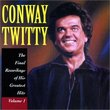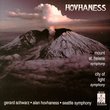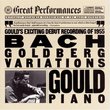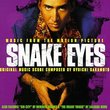| All Artists: Johannes Brahms, Sir Charles Mackerras, Scottish Chamber Orchestra Title: Brahms: The Four Symphonies Members Wishing: 0 Total Copies: 0 Label: Telarc Release Date: 7/29/1997 Genres: Special Interest, Classical Style: Symphonies Number of Discs: 4 SwapaCD Credits: 4 UPC: 089408045028 |
Search - Johannes Brahms, Sir Charles Mackerras, Scottish Chamber Orchestra :: Brahms: The Four Symphonies
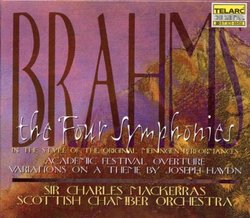 | Johannes Brahms, Sir Charles Mackerras, Scottish Chamber Orchestra Brahms: The Four Symphonies Genres: Special Interest, Classical
This fascinating set of the complete Brahms symphonies reflects Charles Mackerras' researches into late Romantic performance techniques. Using contemporary letters from the composer and his close associates, Mackerras ma... more » |
Larger Image |
CD DetailsSynopsis
Amazon.com This fascinating set of the complete Brahms symphonies reflects Charles Mackerras' researches into late Romantic performance techniques. Using contemporary letters from the composer and his close associates, Mackerras makes a convincing case that conductors of the late 19th century typically preferred very wide variations in tempo within a movement, and a flexible sense of rhythm. This, of course, is something that many conductors have always done, but Mackerras combines the technique with an orchestra similar in size to the one that premiered many of these symphonies, and which Brahms himself preferred. The result is fresh and exciting, with many passages of Brahms' thick orchestration marvelously clarified. Add to this Telarc's gorgeous sound, and the result is a delight. --David Hurwitz Similarly Requested CDs
|
CD ReviewsBrahms without the murk... Andrew M. Klein | 12/04/1999 (4 out of 5 stars) "Finally, Brahms without all that icky thickness that we usually blame him for! This Brahms cycle strikes an excellent balance between clarity and richness of sonority. Mackerras's interpretations are full of vitality -- except in the Fourth, alas! I frankly cannot understand how Mackerras gives such an underpowered interpretation of the Fourth after giving such powerful interpretations of the first three symphonies. Perhaps he views this piece as resigned rather than defiant or tragic. Oh well, no matter. I'm glad I own this cycle. I can't really single out anything in the first three symphonies since everything is excellent. I have a feeling Gardiner will have something to say about these works, but for now, I'm happy with Mackerras, as well as my old Bruno Walter CD for the Fourth. Forget about Herby von K., Lenny B., and all those other people who claim they know Brahms." At Last -- Performances Worthy of the Music! Andrew M. Klein | Washington, DC USA | 05/03/2003 (5 out of 5 stars) "I've been on the hunt for wonderfully performed versions of these magnificent symphonies for years. My love for them was born decades ago listening to the incomparable Toscanini recrdings on LP (performances still happily available on CD and well worthwile despite the unavoidable loss of sonic quality compared to modern recordings). Mackerras's set is simply superb.I couldn't agree less with the reviewer who expresses dislike of Mackerras's version of the First. I cannot think of a peer to this performance and am overwhelmed by what McKerras has done with a work that has few peers in all of the symphonic lterature. My view? Bravo!! Not just to the First, but to all four. My last stop in my hunt before the McKerras versions was the Sandlerling set, which I have reviewed at length at the Sanderling recording site. There I express more completely my admiration for the McKerras recordings, discovered only after I gave up on Sanderling, and my views concering certain other conductors' Brahms efforts. I won't repeat them here, but suggest a visit to the Sanderling cite if you're interested. What I must say, however, in conclusion, is that Brahms does not sound very interesting when performed indifferently. Most of the performances I've listened to, in recordingas and in concert, have been so slow, so overfed (stuffed with lush strings), so droopy and uninspired that I've been slightly surprised that to find anyone who still listens to this music with attention and interest. (The old Toscanini recordings couldn't have been expected to bear the burden of interesting people in this music alone forever.) After hearing the fabulously conducted Mackerras versions, revealing again and anew the incredible, timeless beauty and energy of these great works, I don't think I need fear this any longer.Thank you, Maestro Mackerras!" Go. Buy. Be Happy. John Long | Silicon Valley, CA | 06/30/2005 (5 out of 5 stars) "This is not only my favorite recording of the Brahms 4, but it is in fact my favorite recording of anything whatsoever. There are several reasons for this:
1. It's Brahms. 2. It' his 4 symphonies. If you have never heard them, do so before you die. Which could be tomorrow. So GO! 3. Many have mentioned that this recording is different, that it is supposedly closer to the original way the music was played. Maybe. All I know is that when I listen to other recordings, I can't stand it. The strings overwhelm the winds, and the whole thing is rightly called muddled. This recording is lighter, more nuanced, and you can hear all the parts, including all 4 horns, each woodwind instrument (you don't have to strain to hear the bassoon!) and even the 3 trombones when they are allowed to play. Maybe it's because I learned these pieces playing in the horn section, but to me, it is a crime to mask all these parts that Brahms worked so hard on. 4. OK, some of the tempos are "extreme". But frankly, they work. They give a passion and a fire to these pieces that leaves me dissatisfied without them. Honestly, I think I have listened to these tracks well over a hundred times each. It NEVER get's old. Order this today, and get it priority mail. If you're not happy, there's no helping you." |

 Track Listings (6) - Disc #1
Track Listings (6) - Disc #1
